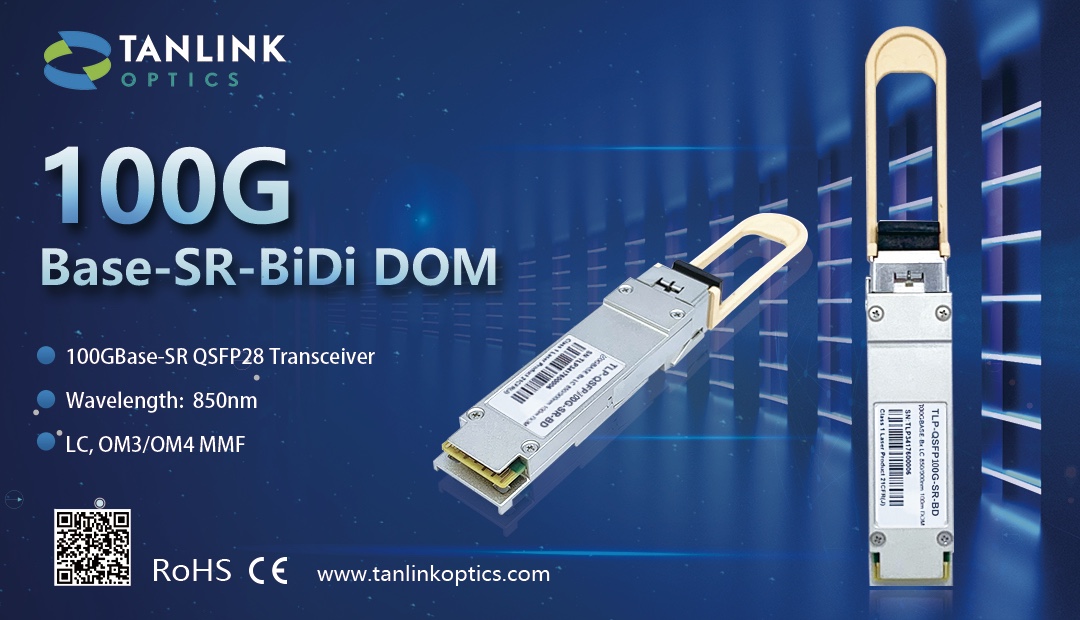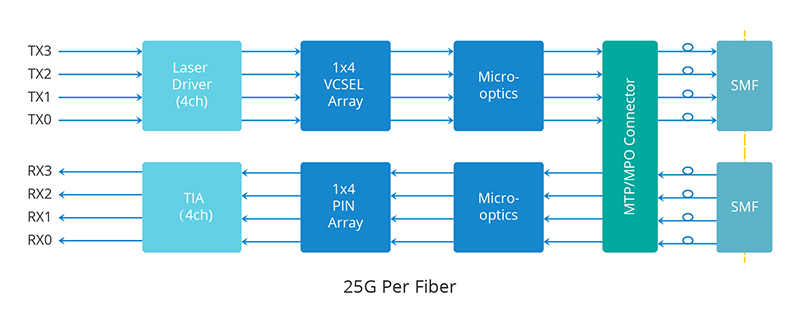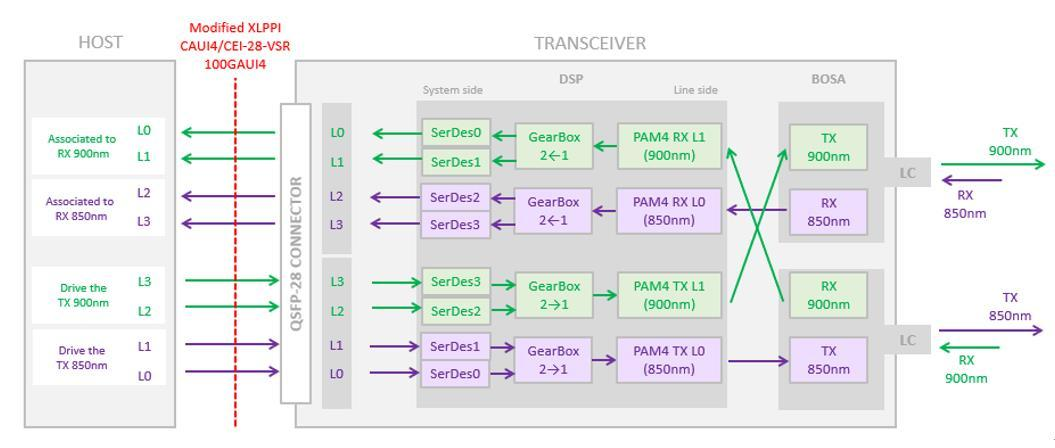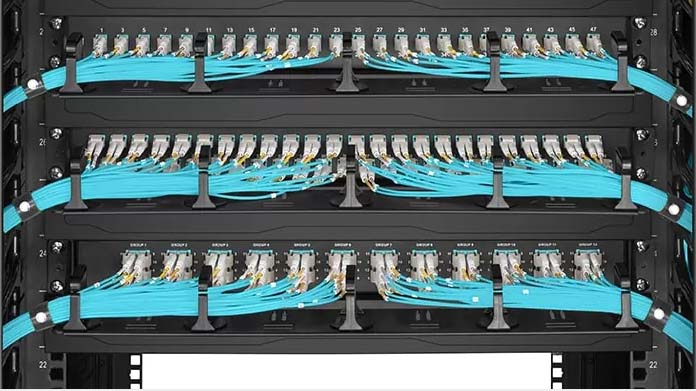Differences between 100GBASE-SRBD and 100G SWDM4 Transceivers
 back
back

With the rise of cloud computing and 5G networks, data centers tend to develop at higher speed, and the demand for 100G optical module is increasing. 100G optical modules nowadays occupies a large proportion of the network construction cost. In the data center application environment, more than 90% of fiber links in small and medium-sized data centers are less than 100 meters in length, more than 70% of fiber links in large data centers are less than 100 meters in length, and more than 80% of them are less than 125 meters in length, so multimode fiber can meet the needs of most links. And that’s why in 100G modules, the largest demand is for 100G multimode modules. The QSFP28 100G multimode module has three mainstream solutions: 100GBASE-SRBD, 100GBASE-SR4, and 100GBASE-SWDM4.
01 Product specification parameters
The 100GBASE-SR4 is the most widely used among the three 100G multimode modules. 100G QSFP28 SR4 is a hot-pluggable, full-duplex optical module with a center wavelength of 850nm, compliant with IEEE 802.3ba standard, and specifically designed for short-range transmission in 100G Ethernet. The 100G QSFP28 SR4 optical module can provide four independent transmit and receive channels, each operating at up to 25Gbps. The 100G QSFP28 SR4 optical module adopts MTP interface (8 cores) and has a transmission distance of 70m when used with OM3 multimode fiber and 100m when used with OM4 multimode fiber. its operation principle is shown as in the following picture.

▲ 100G QSFP28 SR4 optical module working principle schematic
Unlike 100G SR4 which requires eight fibers for transmission, the 100G BiDi (bidirectional) module uses WDM technology to enable each LC port to simultaneously transmit and receive optical signals of different wavelengths from a single multimode fiber, and the two LC interfaces together can transmit and receive 100G signals; the maximum transmission distance is 70 meters when used with OM3 fiber patch cable. When used with OM4 fiber patch cable, the transmission distance can reach up to 100 meters, and with OM5 fiber patch cable, the transmission distance can reach up to 150 meters. Its working principle is shown as in the following picture.

▲ 100G QSFP28 SRBD optical module working principle schematic
100GBASE-SWDM4 is similar to 100G BiDi, both are duplex LC interface; where SWDM (Short Wavelength Division Multiplexing) refers to short wavelength division multiplexing technology, similar to CWDM4 or LWDM4 single-mode scheme. The MUX/DMUX tech enables the transmission of 4 bands of optical signals on a single core of multimode fiber. The windows of the four bands are 850nm, 880nm, 910nm and 940nm; the maximum transmission distance is 70 meters when used with OM3 fiber patch cable, and up to 100 meters when used with OM4 fiber patch cable. Its working principle is shown as in the following picture.

02 Product Application Selection
All three modules are compatible with mainstream 100G QSFP28 ports, and while there are major differences in technical specifications, there are minimal differences in applications: the 100GBASE-SR4 needs to be used with MPO 8/12 core multimode patch cables, while the 100GBASE-SRBD and 100GBASE-SWDM4 both need to be used with duplex LC multimode fiber. From the perspective of fiber resources and cabling cost, 100GBASE-SRBD and 100GBASE-SWDM4 cabling requires only 1/4 of the fiber resources of 100GBASE-SR4, which can significantly save the capital expenditure of fiber infrastructure. However, the cost of 100GBASE-SRBD and 100GBASE-SWDM4 modules is much larger than 100GBASE-SR4, so from the overall cost of optical module + fiber, using 100GBASE-SRBD or 100GBASE-SWDM4, the cost is not necessarily lower than using 100GBASE-SR4.

▲ Data Center Duplex Multimode Cabling
When the overall application cost is actually higher than 100GBASE-SR4, why would a customer choose 100GBASE-SRBD/100GBASE-SWDM4? After communicating with our customers, Tanlink technical staff found that they chose 100GBASE-SRBD or 100GBASE-SWDM4 because the network demand was upgraded from the original 10G or 25G to 100G, and the 10G or 25G network cabling is mainly LC duplex multimode fiber, if QSFP28 100G SR4 module is used, it needs to make large Although both 100GBASE-SRBD and 100GBASE-SWDM4 are duplex LC interfaces, they are technically very different. It is understood that only one vendor in the world produces 100GBASE-SWDM4, which is poor in product ecology and has great instability in product supply. 100GBASE-SRBD has a higher technical threshold, but there are many major manufacturers laying out production, and the product ecology is better developed. For 100G networks in data center duplex multimode cabling environment, Tanlink recommends using 100GBASE-SRBD modules.
“Recommend”
- 800G QSFP-DD Passive Direct Attach Copper Twinax Cable
- 800G Twin-port 2x400G OSFP to 2x400G OSFP InfiniBand NDR Finned Top Active Copper Cable
- 800G OSFP 850nm MMF Active Optical Cable 50m
- Come and Meet us in the exhibition OFC 2024--800G 2x SR4 OSFP Optical Transceiver/800G OSFP ACC
- Merry christmas & happy new year!
- 400G OSFP-RHS SR4 to 400G OSFP-DD SR4 AOC

 Sales@tanlinkoptics.com
Sales@tanlinkoptics.com
 86-18720073189
86-18720073189
 3Fl, C#, Innovative Industrial Zone, Xinan San Rd, Baoan District, Shenzhen,China, 518100
3Fl, C#, Innovative Industrial Zone, Xinan San Rd, Baoan District, Shenzhen,China, 518100
